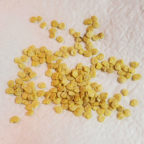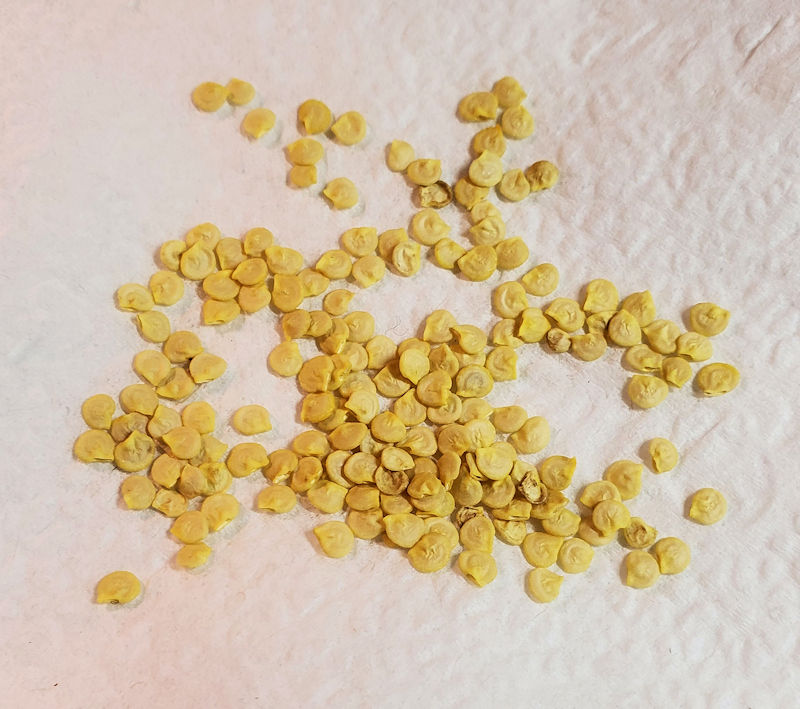Planting Grocery Store Bell Pepper Seeds
Planting grocery store bell peppers – can you do it? Sometimes you taste a bell pepper from the grocery store and it tastes so delicious, so why not save seeds? You can, with some caveats to consider — let’s talk about it.
Saving Grocery Store Bell Pepper Seeds
The very first thing to know if that you have to save the seeds from a ripe pepper — yellow, orange, red, etc. Green peppers are actually immature fruits, so don’t bother trying them (unless you are up for a challenge, LOL).
The next thing is to know that there is a very good chance that the pepper you bought is a hybrid. Hybrid peppers usually don’t breed true (unless the parents are very similar), so you may end up surprised with the fruits that grow. (Please don’t confuse the term “hybrid” with “GMO”; they are not the same thing.)
Finally, you may have a low germination rate, due to various circumstances, so plant more seeds than you think you will need. If they all sprout, great! It’s easier to get rid of the weaker plants, than it is to wait and wait and your seed doesn’t sprout.
Planting Grocery Store Bell Pepper Seeds
Now comes the fun part; saving those seeds and planting them! Here are the steps:
- Cut open your pepper and remove the seeds with your fingers. It’s easiest to do this over a paper plate or paper towl.
- Once the seeds are all out, let them dry out some on the paper plate or on a paper towel. If you’re in a dry climate, 1 day may be fine. In a more humid environment, plan on several days.
- Once the seeds are dry, take a look at them carefully. Discard any seeds which are dark, or which seem misshapen.
- Using your favorite seed starting medium, plant your pepper seeds.
- Water in the seeds well, but don’t leave them in a puddle of water.
- Remember to cover your container with a plastic dome, plastic wrap, sandwich bag or the like. Don’t make it airtight; you just want the container to keep some of the moisture in.
- If you have a seed germination mat, please use it; peppers really like to have bottom heat for germinating!
- Check your container every few days; if it seems dry, mist the seed starting medium with some warm water.
Peppers usually take between 5 days to 2 weeks to sprout, depending on the environment and the pepper itself. Don’t give up until it’s been 3+ weeks and no sign of germination. By planting extra seeds, you raise the chances of getting at least one to sprout!
(Note: If you are trying to germinate a habanero or other really hot pepper, they may take 4 weeks to germinate — don’t give up on them until 5+ weeks.)
You don’t need to put your seeds under a light for them to germinate, but once they do, move the seeds to a sunny windowsill or under a plant grow light. And once your weather gets warm enough (70+ degrees days, no lower than 55 degree nights) you can plant them outside. Here are some more tips on growing bell peppers.
Peppers grow well in containers (which is how I grow mine these days). I usually will plant 1 pepper in a 3-gallon container, or two plants in a 5-gallon container.  You can obviously also plant them in the ground.
Set the peppers in an area where they get at least 6 hours of direct sun a day.
Now because you have no idea as to what pepper variety your seeds came from, it’s hard to know how long it will take your seedling to go from planting out until you have some “green ripe” peppers, much less fully ripe (red, orange, yellow, etc.). And again, likely the pepper you saved seeds from was a hybrid, so you won’t know exactly what your pepper will end up like until it produces the fruit.
Have fun growing your grocery store pepper plants!
Growing Peppers From Seeds, Part 2
I got a little carried away describing some different pepper seeds for different climates in my previous growing peppers from seeds post. So now let’s talk about the actual planting process.
What You Need
You’ll need the following to plant your pepper seeds. I germinate mine indoors, and then transplant them a little later. So here’s how to plant the seeds indoors, followed by directions for sowing seeds directly outdoors.
For indoors you will need:
- 3-ounce Dixie cups or windowsill seed starter tray.
- Spoon.
- Waterproof container to hold the cups (not needed if you are using the seed starter tray).
- Seed-starting soil or peat cylinders (comes with the seed starter tray).
- Hand sprayer that sprays a very fine mist of water.
- Scissors (if using Dixie cups).
- Seed packet(s).
Optional
- Labels to mark the pepper variety, plus a marker with waterproof ink.
Getting the Containers Ready
First, get the container(s) (Dixie cups or seed starter tray) ready with the soil, then dampen the soil. If you are using the Dixie cups, use the scissors to cut 4 small holes towards the bottom of the cups, for drainage. If you are using the seed starter tray, soak the peat cylinders in water according to the directions.
I like to use a small spoon to get the seed-starting soil into the Dixie cups.
If you are planting several varieties of seeds (which is what I like to do), you may want to label your containers with the varieties. You can use the waterproof markers and labels for the Dixie cups, or sketch a simple diagram of the windowsill seed starter tray.
Planting the Pepper Seeds
Once the soil or cylinders are damp. place the seeds in the cups/cylinders. I tend to plant 3 seeds in each Dixie cup, thinning to the strongest if they all germinate. Follow the directions as to number of seeds for the seed starting tray.
For the Dixie cups, you then want to place a fine layer of soil over the seeds. Don’t make it too deep, or the seeds will lose their strength just trying to get above ground.
When you are done planting, spray a fine mist of water over the soil. If you’re using the Dixie cups, put them in a waterproof container.
Then put some water at the bottom of the seed starter tray or the waterprood container. You want to water from below, to encourage the tiny plants to grow their roots deep instead of shallow. But be careful not to drown them! You want the soil damp, not wet.
You’re done! Now put the tray or container in a spot where it will be warm. When the seeds start to germinate, move them to somwhere where they will get plenty of indirect sun, or under grow lights.
Growing Peppers by Sowing Outside
It’s actually fairly simple to sow directly outside, but you must wait until all danger of frost is past, and the soil needs to be at least 60 degrees warm. Pick a sunny spot where the pepper plants will get plenty of sun.
Your biggest job will be preparing the soil outside. You want it loose enough so that the peppers can poke their heads above soil easily, but with enough nutrients to keep them going.
When I planted my peppers outside, I put plenty of compost and cow manure into the soil, then thoroughly mixed it to a depth of 6 inches. Depending on your soil, you may or may not need a tiller to help you with this. Dampen the soil when you are done; you want it moist, not wet.
Once your soil is prepared, plant your seeds about 18 inches apart. I like to plant three seeds in each set, then thin to the strongest one.
Cover the seeds with a fine layer of seed-starting soil, which makes it easier for the young plants to poke their heads above ground once they germinate. Mist with a sprayer until the soil is damp over the seeds.
And Now the Hard Part
The hardest part is waiting for the seeds to germinate. I’ve had them take as few as 5 days to as long as 3 weeks, and different varieties take different lengths of time to germinate. Just be patient and keep the soil moist.
There you go — planting your pepper seeds! If you’d like more detail on planting seeds of any kind, one book I like a lot is The New Seed Starter’s Handbook. Very detailed, you’ll be growing your own garden from seed in no time!

